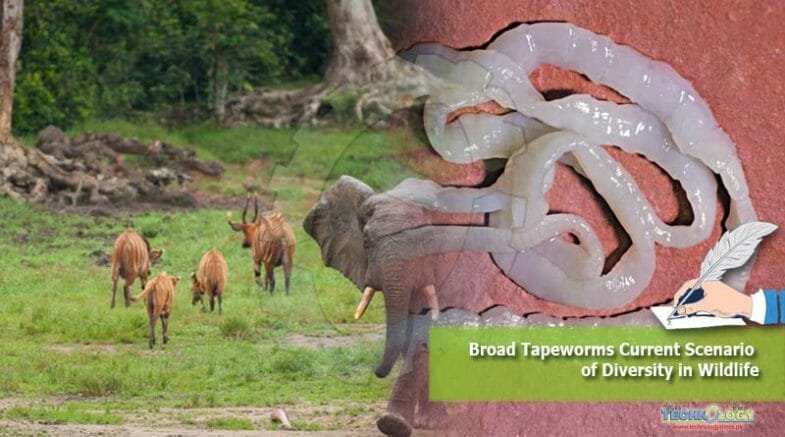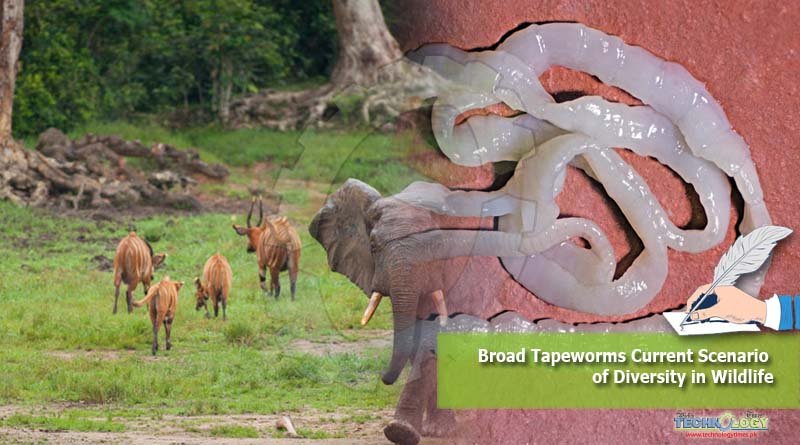Broad tapeworms are the parasites belong to family Diphyllobothriidae which are notorious in nature and pose great threat to public health.
 Diphyllobothrium genus belong to this family and causes diphyllobothriasis in many animal species and infection is also prevalent in human population.
Diphyllobothrium genus belong to this family and causes diphyllobothriasis in many animal species and infection is also prevalent in human population.
Wild and Marine animals are mainly the target population for such infection. It has been observed that in whales these tapeworms may reach length up to 30m. Diphyllobothrium was previously known as Taenia lata which was named by Linnaeus in 1758. There are studies which indicate that infection rates were higher in humans and there was problem with diagnostics. But, due to advancements in recent century regarding molecular techniques have made it really convenient for researchers to identify and root out the cause of infection.
There is great diversity in life cycles of these broad tapeworms. In humans the infection was identified for the first time in 1747 by H.D. Sporing. The cause of infection was fish consumption. Fish is the main culprit for transmission of this parasite. When it was identified for the 1st time in humans, the infection was prevalent in those areas where populations were near water bodies like riverbanks and canals.
Animals were experimentally infected, and eggs were isolated from faeces of infected animals. Human beings are mainly infected by Dibothriocephalus and Spirometra of this family (Diphyllobothriidae). These species Adenocehpalus pacificus, Dibothriocephalus dendriticus, Dibothriocephalus latus, Dibothriocephalus nihonkaiensis, Diphyllobothrium balaenopterae and Diphyllobothrium stemmacephalum are genuinely present in humans and lead to severe ailment. All above are parasitic species infect terrestrial and aquatic animals. It has been assumed that the infections in humans are basically in result of zoonoses.
Broad tapeworms of terrestrial and marine animals have higher capability of surviving in human intestinal environment as compare to birds. But, Dibothriocephalus ditremus is present in birds and incapable of infecting humans. So, for this there are ecological factors which play major role as compare to evolutionary factors. Human infection is due to consumption of under cooked or raw fish, amphibians and snakes, this is the clear indicator of zoonotic transmission of these broad tapeworms. Broad tapeworms are the distinct group of cestodes which have ability to infect all tetrapod organisms as well as humans.
This parasite group has been neglected for many decades, but through infecting wild animals this group regained the attention of parasitologists, Moreover, the human case reports from different countries are on rise. Spirometra is among these broad tapeworms and causes human sparganosis. Actual assessment regarding human infections/case reports is still missing. But the molecular techniques which are advancing day by day have gained attention of researchers to go further in research regarding broad tapeworms. The life cycle of Diphyllobothriidae members is always connected with aquatic environment (freshwater or marine), the first larva (coracidium) is aquatic and needs to go through the first aquatic intermediate host which is a copepod.
Two intermediate hosts are involved: copepods as first intermediate host and the vertebrates as second intermediate host. The second intermediate host with the exception of the genus Spirometra are freshwater or brackish-water fish. In contrast, the life cycle of species of Spirometra includes a wide spectrum of reptiles, amphibians, birds or mammals as second intermediate hosts, but never fish.
The 2/3 population of broad tapeworms is present in marine animals. In literature there 37 species of broad tapeworms out of 58 total species which have been identified in marine mammals. Among these species there are 17 species which mainly infect Sealions. A. pacifictus is a broad tapeworm which infect only eared seals. The infection rates in seals are quite higher because of their feeling habit. Sealions consume raw fish which play role of intermediate host for these tapeworms, so the prevalence sometimes reaches up to 100%.
This is an alarming situation, so in wild animals the control and transmission are literally impossible till now, as well as the species of worms are evolving day by day as there is progression in science regarding diagnostics and treatment of such infections. It has also been observed that these parasites can even survive in severe weather conditions within the host like in seals the prevalence was observed higher whose habitat was arctic. In sealions when they were examined there were 3,6,00,000 specimens of D. mobile (broad tapeworm). Case reports regarding infection in leopard sealions has been published. Molecular studies like genomic analysis of these peculiar parasites is still in process, roundabout 8 species of broad tapeworms have been characterized from China and Korea. The basic aim of this research was estimation of genomic similarity among these broad tapeworm species. Along the wild animals’ human cases are also on rise. 1600 human cases have been reported till 2015.
Conclusion
These broad tapeworms are the largest worms that infect both animals and humans. There is quite less literature regarding their molecular detection and genetic studies. This group gained attention in recent years because of higher rate of infection in wild animals and humans. Infection rate which is quite high is due to feeding habits of humans and animals. Currently, there is need of research regarding their mode of transmission and their control in wild animals. These wild animals play major role in transmission. It’s quite challenging situation to cope these parasites in wildlife due too much diversity among animals and parasites.
Authors: Hammad Ur Rehman Bajwa1,*, Muhammad Kasib Khan1, Zaheer Abbas1, Nauman Iftikhar1, Ahsan Adeel2, Muhammad Umair Abdullah3
- Department of Parasitology, University of Agriculture, Faisalabad
- College of Pharmacy, Punjab University Lahore
- Department of Chemical Engineering, Punjab University, Lahore
